Best & Worst Kitchen Cabinet Material: Pick or Skip
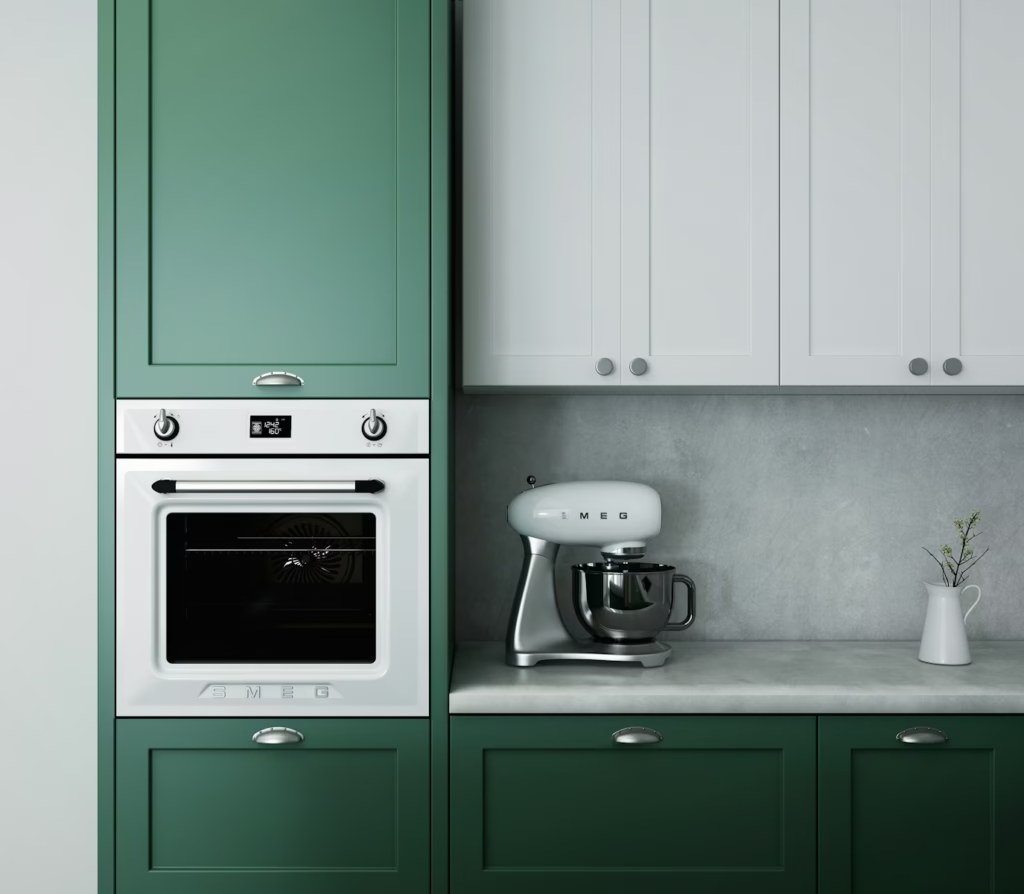
If you’re redoing the kitchen and looking for kitchen cabinet material, then this guide on the Best & Worst Kitchen Cabinets Material: Pick or Skip is going to save you time and money in the long run.
Here we’ll discover the best and worst options ranked by durability, moisture resistance, and budget.
Know what to pick and what to skip!
Best & Worst Kitchen Cabinet Material: Pick or Skip?
Choosing the right kitchen cabinet material is one of the most important decisions you’ll make when creating your kitchen, and it isn’t just about picking the prettiest shutters or following what’s trending on Instagram or Pinterest.
Picking the best kitchen cabinet material is about knowing what actually lasts, what you’re paying for, and whether it will survive your daily kitchen use – the stream, the species, the water splashes…the actual use.
Sadly, many homeowners don’t know what goes on behind their cabinets. And worse, sometimes even the contractors and carpenters don’t care to tell.
Here’s the hard truth: not all “premium” brands popular in the market sell premium quality. Many brands don’t disclose material grades or certifications like IS:710 BWP (boiling water proof ply wood) or IS:303 BWR (boiling water resistant), and you only realize the compromise when edges bloat, hinges rust, or the drawers give way within one year.
The right or wrong kitchen cabinet material impacts durability, appearance, ease of cleaning, and how your cabinets will handle years of daily use, moisture, and heat.
So, whether you’re doing a basic kitchen setup or going all out with custom cabinets, know this: a beautiful kitchen starts inside – the carcass material (the body), the shutter finishes, edge-banding, the type of hinges, and channels – this is where your money should be going and not just into glossy brochures.
In this guide, I’ll rank and explain the best and worst kitchen cabinet material options based on expert advice, field-tested reviews, and global standards used by professional interior designers, modular kitchen brands, and architects, to help you make a smart decision, whether you’re remodeling or building from scratch.
This guide is informed by materials research and advice from:
- FII India (Forest Innovation Investment) for engineered wood recommendation.
- Greenply or CenturyPly for product performance rating
- Hettich and Hefele for hardware compatibility (the best hinges are a must for making the cabinets work)
- Professional guidance from Houzz, Livspace, and Urban Company modular kitchen consultants.
- Construction durability reports from IS:710 (BWP Plywood) and IS:303 standards
Related Reads:
- Which is the Best Mattress for Your Bedroom? 2025
- Which Bed is Best for Your Bedroom? Complete Guide
- False Ceiling Designs For Bedroom
- 37 Small Space Saving Tips You Should Know
- Finding The Best Curtain Type for Your Living Room
- Best Buying Guide on Big Carpets
- 10 Hard To Kill Indoor Plants For Busy People
How is Each Kitchen Cabinet Material Ranked in this Guide?
I have scored each material based on:
- Durability and Longevity
- Moisture and termite resistance (silent cabinet killers)
- Ease of maintenance
- Screw-holding scratch
- Compatibility with finishes (like laminate, paint, or vaneer)
- Cost-effectiveness (Always keep a check on your budget)
Tip: The best picks combine strength and stability with low upkeep. The worst kitchen cabinet materials don’t hold up well, and you’ll see the wear, tear, and high maintenance requirements more quickly during everyday kitchen conditions.
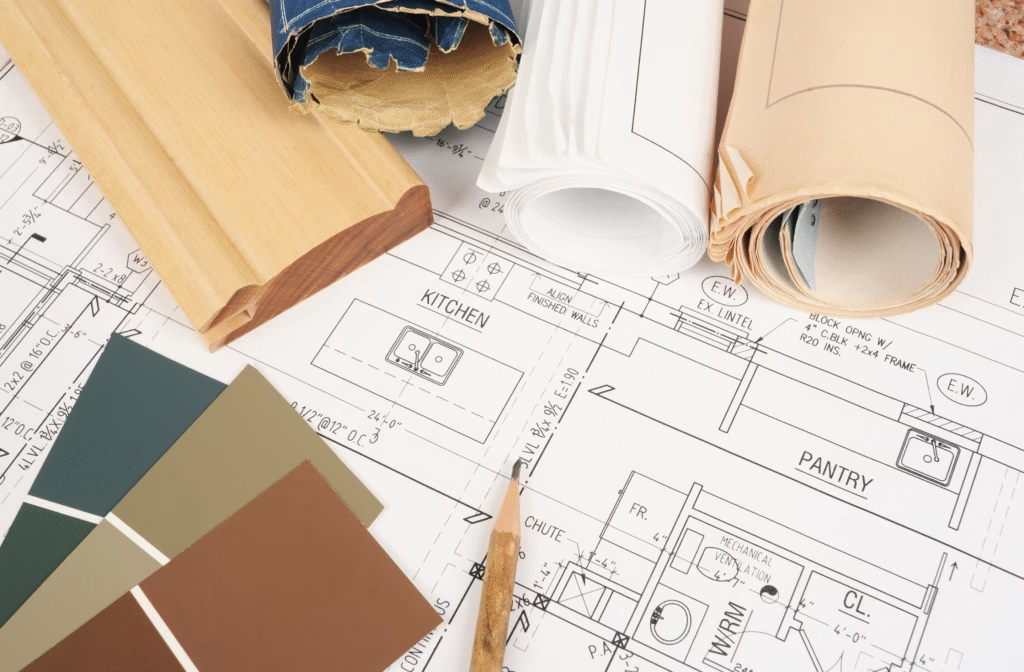
What do “IS Standards” mean, & Why must we know them?
Don’t be lured by just appearances. Ask about material grades for your kitchen cabinet materials. Ask for water resistance, pest resistance, and edge-sealing. Ask if it’s suitable under the sink or in coastal weather. Because at the end of the day, your kitchen should work for you and not just look good for a day.
So, before we start ranking materials for kitchen cabinets, it is important to know a few things, like the IS Standards and why we must be aware of them.
If you’ve come across labels like IS:303 or IS:710 while shopping for plywood or kitchen cabinets in India, you’re not alone in wondering what they actually mean.
In India, these are part of the official Indian Standards for quality assessment, approved and granted by the Bureau of Indian Standards (BIS). This system tells you the quality, strength, and water resistance of materials commonly used in kitchens and furniture.
Most people don’t know what they’re buying, and this often leads to bad investments in kitchen cabinet material that don’t last or warp too quickly. I’ve been a victim of such bad investments myself when I got my kitchen remade, so I know how utterly frustrating it is to simply trust the words of your carpenter or the seller, without having the proper knowledge to make a sound decision. It hits hard when you learn your lesson after wasting your time, money, and effort.
So, understanding these standards helps you make better buying decisions, especially when you’re comparing materials that may look similar on the outside but perform very differently over time.
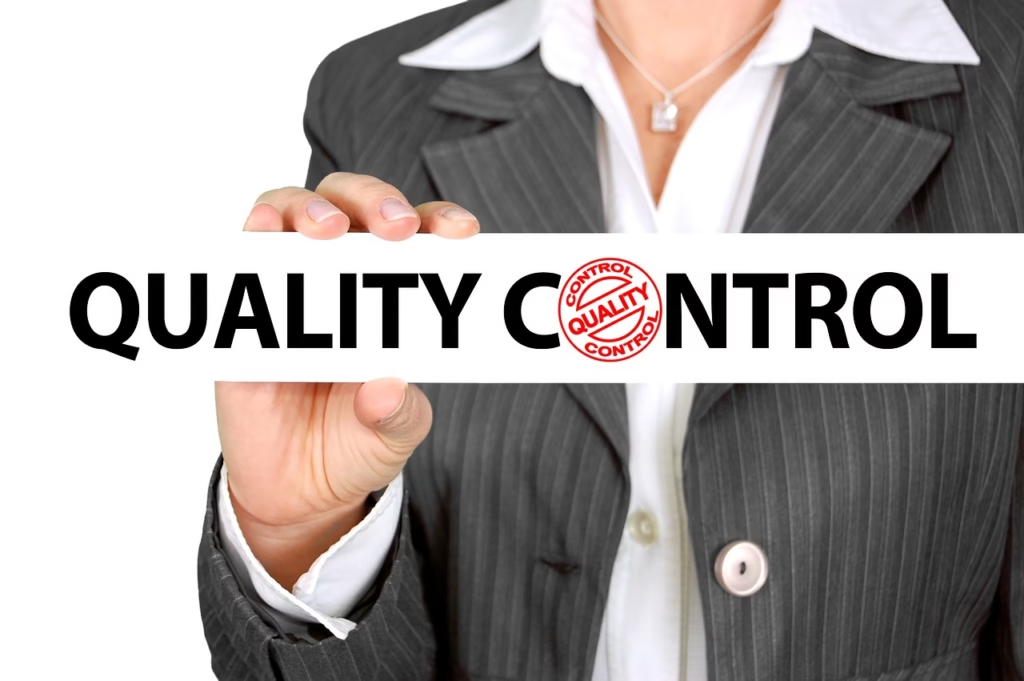
These standards are tested for:
- Water resistance (how well the material holds up against moisture, spills, and humidity, especially critical in kitchens and bathrooms)
- Adhesion strength (tests how strongly the plywood layers or lamination stay bonded, so the material doesn’t peel or fall apart)
- Formaldehyde emissions (measure the release of harmful chemicals. Low emissions mean it’s safer for indoor air quality)
- Load-bearing capacity (checks how much weight the material can safely support, important for shelves and carcass strength)
- Surface durability (how well the surface holds up against scratches, stains, heat, and daily wear-and-tear)
Let’s break it down and also look at how this system compares to what’s followed in the US, UK, and other countries around the world.
Indian Standards: IS Codes You Should Know
| Standard | Grade | What it means? | Best Used For |
|---|---|---|---|
| IS:3O3 | BWR (Boiling Water Resistant) | Handles moderate moisture | Wardrobes, low-moisture kitchens |
| IS:710 | BWP (Boiling Water Proof) | Can handle constant water exposure | Modular kitchen carcasses, bathrooms |
| IS:1659 | MR (Moisture Resistant) | Basic grade for dry interiors | Bedroom furniture |
| IS:10701 | Marine Grade | High-performance | Boats, exterior cabinetry |
Always check if your plywood mentions these codes, as it’s a sign of quality, not just branding.
International Standards
| Country | Grading Body | Standard | What It Covers |
|---|---|---|---|
| USA | ANSI (American National Standards Institute, HPVA | ANSI/HPVA A208, HP-1 | MDF, particleboard, hardwood plywood |
| Europe: | EN (European Norms) | EN 312, EN 314/636 | Water resistance, strength |
| Canada: | CSA (Canadian Standards Association) | CSA 0112 | Plywood and moisture protection |
| Australia: | AS/ NZS Standards | AS/NZS 2269 | Structural & marine-grade plywood |
So, whether you’re buying cabinets in India or abroad, understanding these standards will save you from investing in poor-quality materials that may look good but won’t last long.
Look for IS codes or international equivalents to be sure you’re choosing from material that suits your space, moisture levels, and long-term needs.
Top 8 Kitchen Cabinet Materials (From best to worst)
- BWP/BWR Plywood
- HDHMR (High-Density Moisture Resistant Board)
- HDF (High Density Fibreboard)
- MDF (Medium Density Fireboard)
- Solid Wood
- Stainless Steel
- PVC/WPC (Wood Plastic Composite)
- Particleboard
1. BWP/BWR Plywood
This is the best performer in the market for kitchen cabinet material. BWP (boiling water proof) and BWR (boiling water resistant) plywood are the gold standard for kitchen cabinetry.
These are made of multiple layers of hardwood veneer bonded with strong phenolic resins. They have extremely high resistance to moisture, offer unmatched screw-holding capacity, and stay structurally stable under weight, heat, or movement.
BWP/BWR Plywood is also compatible with every popular surface finish, like laminate, acrylic, veneer, and PU paint.
In short:
BWP Grade Plywood is –
- It’s fully waterproof, tested to withstands 72 hours of boiling water
- Resists warping, delamination, fungal growth
- Stays stable in high-humidity zones likes under sinks
- For even better protection, laminate both sides and seal the edges with edge banding or PU paint to block moisture completely.
Marine Grade Plywood –
- Designed for extreme moisture environments (like boat interiors), it’s even more durable than BWP plywood but more expensive.
- It is best for luxury kitchens or exposed under-sink areas with long-term durability in mind.
- If budget allows, add an aluminum mat or PVC layer inside the base of the under-sink cabinet to prevent water from soaking in, even with BWP-grade material.
PU Paint, short for polyurethane paint, is a strong, versatile coating known for both its durability and visual appeal. Being polymer-based paint, it creates a smooth, smooth, often glossy finish that not only looks polished but also extends the life of surfaces like wood, metal, and plastic. Its high resistance to chemicals, scratches, and UV rays makes it ideal for indoor and outdoor use.
This material is used for:
- Carcass and shutters.
In kitchen design, the term “carcass” refers to the internal structure or framework of a cabinet – the part that holds everything together. It’s the box-like body of the cabinet that includes the sides, bottom, top, and back.
The carcass is usually made up of materials like plywood, MDF, or particleboard and is responsible for providing strength and stability to your kitchen cabinets.
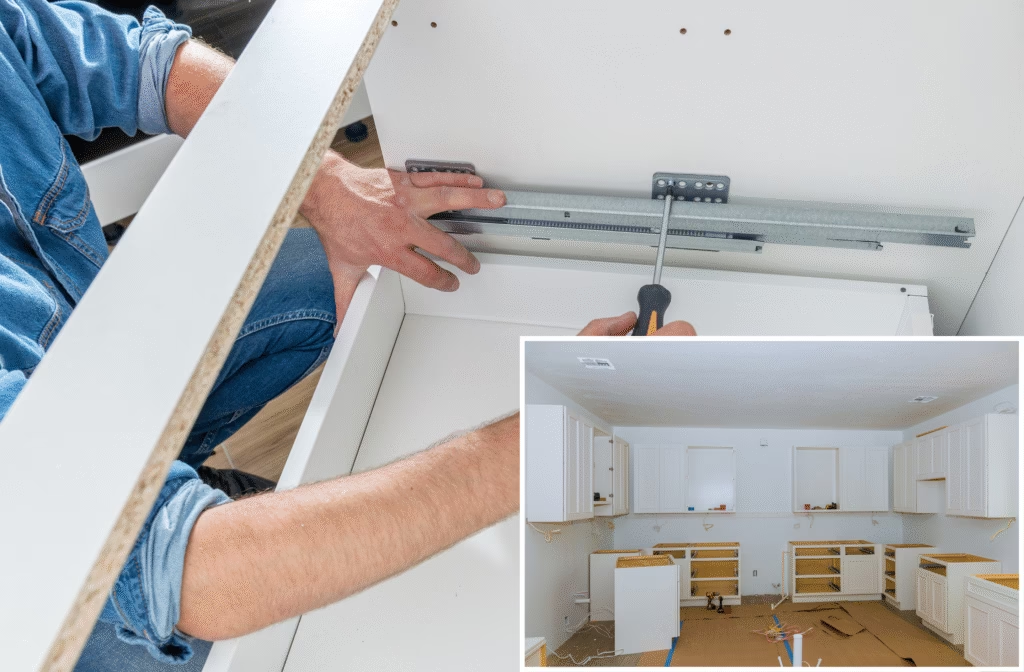
Think of it as the skeleton of the cabinetry. It’s not usually visible once everything is installed, but it’s what keeps the whole system functioning.
On the other hand, “shutters” are the visible outer panels, such as the cabinet doors and drawer fronts. These are what you see when you look at your kitchen cabinets.
Shutters are all about appearance and access; they define the overall look and style of your kitchen, from modern glossy, matte, or classic wooden texture finishes.
In short, the carcass gives your kitchen structure, while the shutters give it personality.
Standard:
- IS: 710 (BWP), IS:303 (BWR)
2. HDHMR (High-Density Moisture Resistant Board)
Engineered from high-density fibreboard treated with moisture-resistant resins, HDHMR outperforms standard MDF and HDF in terms of density and moisture handling.
It offers a smooth surface for paints and laminates, resists swelling in moderate humidity, and holds screws well, especially for shutters (this is important, guys, always make sure your carcass and shutters go well together, otherwise you’re gonna have ready-to-fall leaning shutters sooner than you think!) .
HDHMR is not ideal for under the sink, but is great for painted and routed finishes.
- HDHMR, while moisture resistant, it’s not fully waterproof, so it can swell or degrade over time if exposed to standing water or leaks under the sink.
This material is used for:
- Shutters or dry-zone cabinets
Standard:
- No, as of now, there is no specific IS Code dedicated solely to HDHMR. Instead, it is classified under IS:12406, which covers medium-density fibreboards (MDF) in India.
- As per global standards, HDHMR aligns with EN 622-5 (Europe) for moisture-resistant MDF and ANSI A208.2 (USA), which categorizes MDF based on density and internal bond strength.
- HDHMR is not a separate standard, but a commercial grade of MDF that exceeds the general moisture resistance and density of regular.
- Brands known for quality HDHMR – Action TESA, Century, Greenpanel
- Manufacturers label it HDHMR to differentiate it from standard MDF, based on higher fiber density, better moisture resistance, and enhanced screw holding and machine quality.
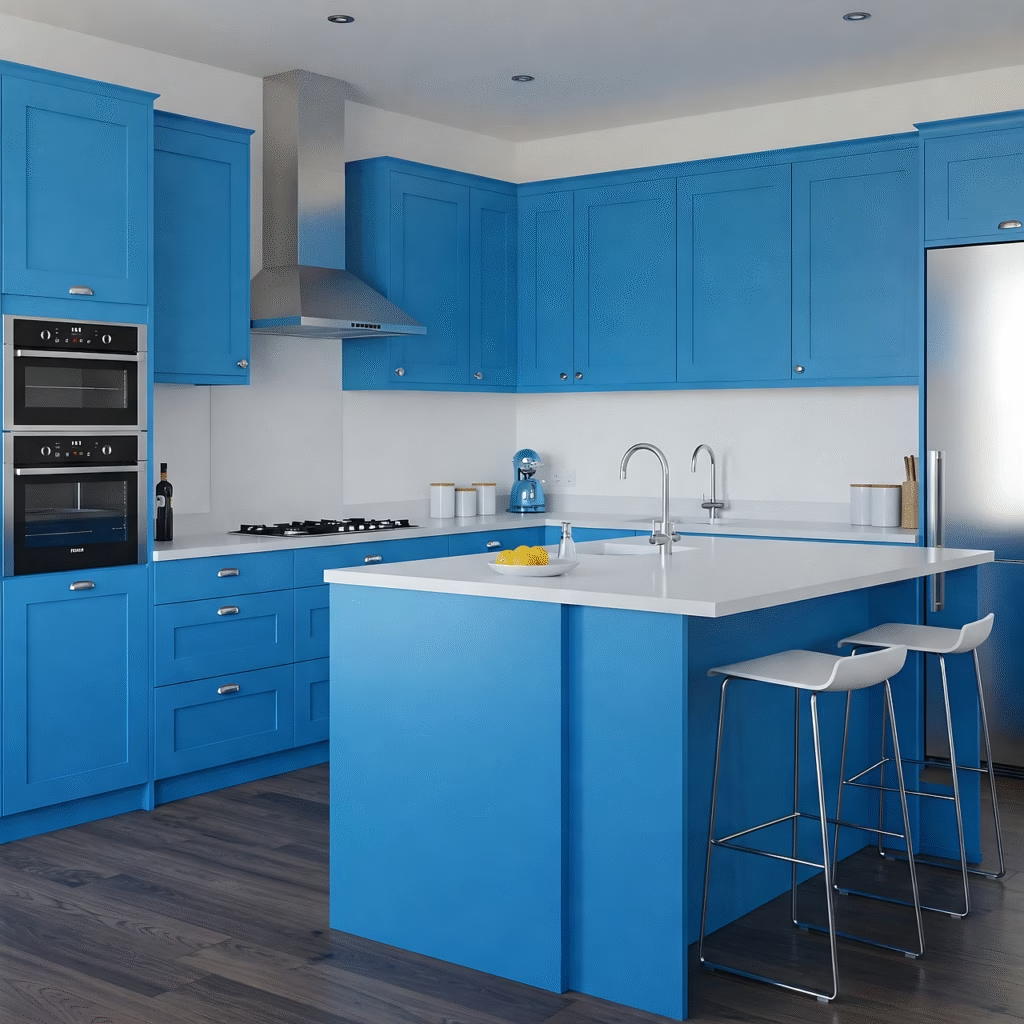
3. HDF (High Density Fibreboard)
Denser than MDF, HDF offers excellent stability for painted or fluted shutters. It resists minor impacts better than MDF and is smoother for intricate detailing. However, it’s less moisture resistant than HDHMR and must be sealed well, particularly on edges, to prevent damage.
Compared to MDF, HDF is more resistant to minor dents or knocks, which means it holds up better in busy households. It works best in dry areas and avoids surface chipping when routed.
The downside of HDF is that it’s less moisture-resistant than HDHMR. That means if exposed to water or humidity (like near a sink or in coastal regions), it can swell or get damaged, especially around the edges. To prevent this, it’s important to seal all exposed edges properly, either with edge banding, paint or laminate.
- Remember, this is not for carcass or wet zones
This material is used for:
- Painted shutters and decorative fronts
Standard:
- HDF falls under the broader classification of fibreboards in Indian and international standards
- Indian standard for HDF IS:12406 specification for medium density fibreboards for general purpose. But it does not have a separate IS code in India as of now.
4. MDF (Medium Density Fireboard)
MDF is a budget-friendly board. It is a type of engineered wood made by breaking down hardwood or softwood into fine wood fibres. These fibres are then mixed with resins and wax, pressed into dense, flat sheets under high temperature and pressure. Thus, it is often eco-friendly as its made from recycled wood fibres.
MDF is commonly used for its smooth surface, unlike solid wood or plywood, and ease of cutting. Its smooth and uniform surface makes it ideal for painting, veneering, laminating, and intricate design cuts.
It’s ideal for low-cost paint jobs or membrane finishes. However, it has poor screw-holding strength and absorbs moisture quickly, making it unfit for carcass or humid kitchens.
This material is used for:
- In-budget shutters in dry zones.
- Avoid using them for carcass, under-sink, and in coastal area homes. They’re not moisture-resistant.
Standard:
- IS:12406 covers MDF boards used for general purposes in furniture and cabinetry.
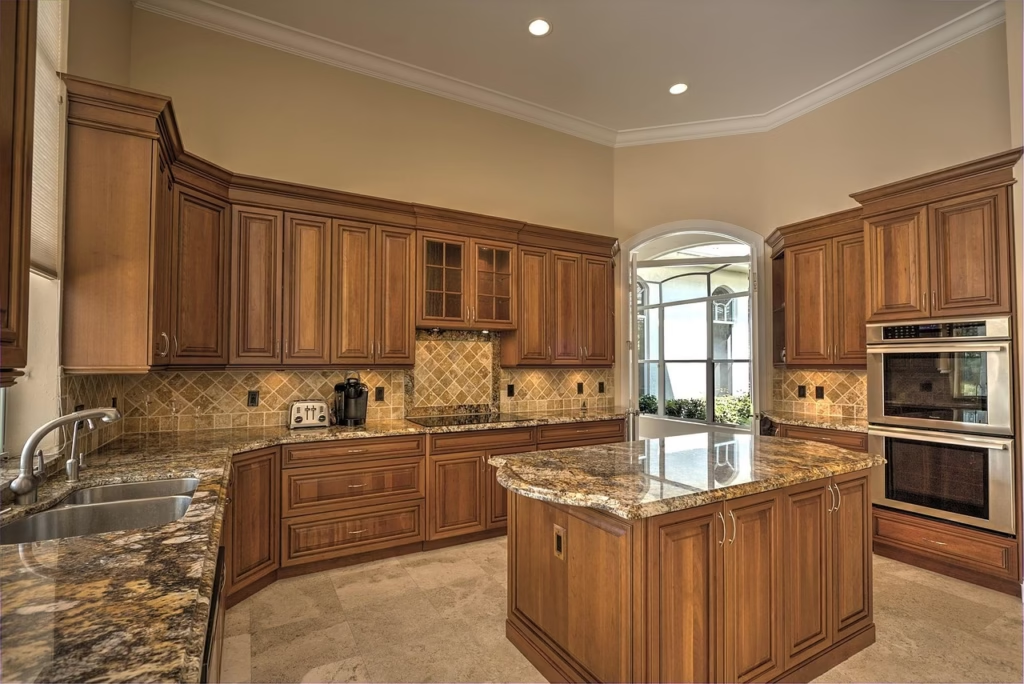
5. Solid Wood
Solid wood is your natural lumber cut directly from trees, without being engineered or mixed with other materials. It’s your most traditional and premium material used in furniture, cabinetry, and other interior works.
Solid wood is prized for its durability, strength, and timeless aesthetics. Each piece of solid wood has a unique grain pattern and texture, and with proper care, it will last for a long time.
Unlike MDF or plywood, which are man-made boards, solid wood is one single piece of wood. Common types used in kitchen cabinets include teak, oak, maple, sheesham, walnut, and pine.
The downside of solid wood is its price and high upkeep. It is often the most costly kitchen cabinet material. It can expand and shrink as it is sensitive to humidity and temperature changes. It’s high upkeep because it needs polishing and sealing over time.
Also, it is heavy and not ideal for upper cabinets unless structurally approved. You can use solid wood for the drawer fronts and frames of your cabinetry.
This material is used for:
Used for utility, commercial, and outdoor.
Can solid wood be used in coastal homes?
Technically, yes, but with serious limitations. Solid wood is not the ideal material for coastal homes unless. It’s a weather-resistant hardwood like teak, white oak, or mahogany. It’s properly seasoned, sealed, and maintained. It’s used in well-ventilated, protected indoor spaces, not near high humidity. But remember, solid wood is not recommended for coastal homes as it is highly reactive to moisture, salt-laden air accelerates decay, and termite and fungal risks are higher in tropical and coastal climates.
Standard:
No specific IS code like IS:710 or IS:303 applies to “solid wood” in general, but there are related standards for wood:
| Standard | Applies To | Specifics |
|---|---|---|
| IS:287 | Seasoning of timber | Specifics how wood should be dried to reduce moisture movement |
| IS:1708 | Testing of timber | For strength, hardness, moisture content, etc. |
| FSC/PEFC | Global sustainable wood certification | Not Indian, but it shows responsible sourcing |
6. Stainless Steel
Stainless steel (304 grade) is non-porous, fireproof, and pest-resistant, which makes it excellent for utility or commercial kitchens. It performs brilliantly under harsh conditions but is costly, lacks warmth in aesthetics, and may amplify kitchen noise. It’s rarely used in full home kitchens due to its industrial look.
So, this material handles heat, spills, and rough usage without warping or degrading, and it’s virtually maintenance-free. However, it’s expensive, has a cold, industrial aesthetic, and can amplify noise, especially in larger kitchens.
For these reasons, it’s rarely used for full cabinetry in home kitchens, but may be ideal for under-sink cabinets, utility zones, or modern-industrial designs when paired with warm finishes like wood or matte laminates.
This material is used for:
Utility, commercial, outdoor, coastal homes
Standard:
- In India, IS 6911:2017 is the Indian standard for stainless steel sheets and strips for utensils and kitchen appliances. It covers austenitic grades like 304, 316, etc.
- It specifies chemical composition, mechanical properties, and tolerance levels.
- Grade 304 under IS 6911 is the most common for kitchen use due to it’s corrosion resistance and food safety.
| Religion | Standard | Description |
|---|---|---|
| USA | ASTM A240/ A240M | Standard for chromium and chromium-nickel stainless steel plate, sheet, strip for pressure vessels and general applications. Covers 304 and 316 grades. |
| Europe | EN 10088-1, 10088-2 | Specifics stainless steel grades, properties, and processing methods for both general and kitchen grade use. |
| Global (ISO) | ISO 15510 | Defines the chemical composition of stainless steels. It aligns with ASTM and EN equivalents for global consistency. |
Always look for SS 304 confirmation and ask for compliance certificates if you’re buying stainless steel kitchen cabinetry, especially in modular or custom setups.
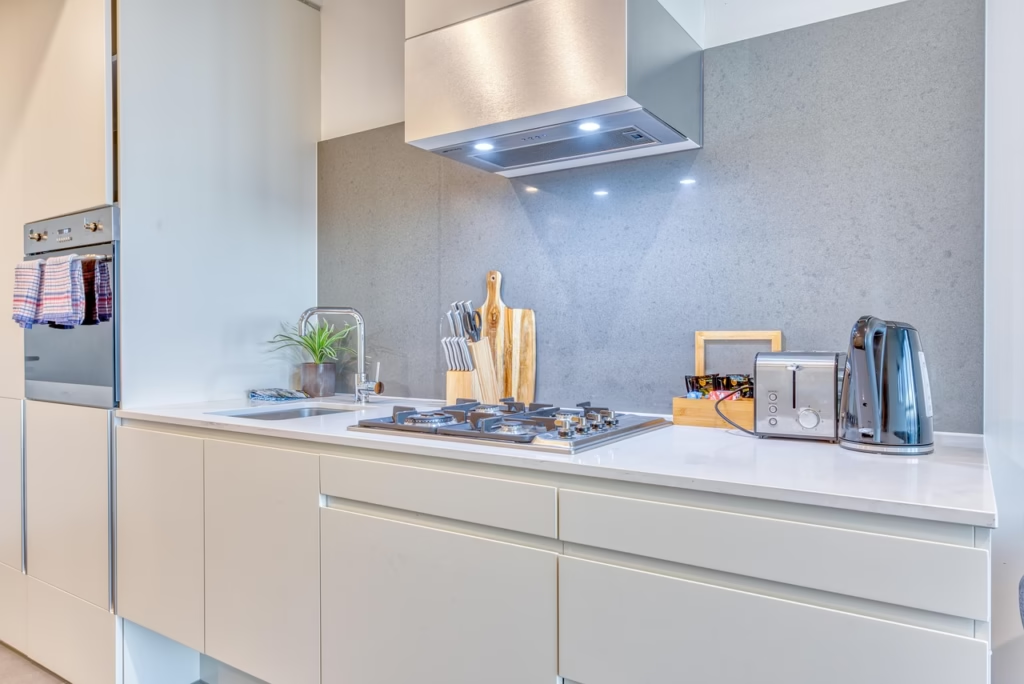
7. PVC/WPC (Wood Plastic Composite)
Although PVC/WPC are waterproof and termite-proof, these boards have poor screw-holding capacity, low strength, and tend to sag over time.
Their plastic look is not premium, and they often emit VOCs if not branded. They’re best used under the sink, where water contact is unavoidable, but not suitable for structural load-bearing.
Avoid using it for major structural cabinetry or tall units. It is the last resort for kitchen cabinet material/ utility use.
This material is used for:
- Under sink base cabinets only.
Standard:
In India, WPC is not yet regulated by a dedicated BIS (Bureau of Indian Standards) code specifically for cabinetry. However, there are testing and classification standards in place related to WPC boards used in construction and interiors.
- IS:17387:2020 – Wood Polymer Composite (WPC) boards specification
This is the official Indian standard for WPC boards used in:
- Furniture
- Interior
- Wall paneling
- Modular cabinetry
What IS:17387:2020 checks for:
- Surface hardness
- Water absorption
- Flexural strength
- Screw holding capacity
- Dimensional stability
- Density
Note: This standard helps buyers understand which WPC boards are suitable for interior use, like kitchen carcasses, and ensures consistency in quality across manufacturers.
elated Reads:
- Which is the Best Mattress for Your Bedroom? 2025
- Which Bed is Best for Your Bedroom? Complete Guide
- False Ceiling Designs For Bedroom
- 37 Small Space Saving Tips You Should Know
- Finding The Best Curtain Type for Your Living Room
- Best Buying Guide on Big Carpets
- 10 Hard To Kill Indoor Plants For Busy People
8. Particleboard – To be Avoided for Kitchen Use
Particleboards are low-density boards made from wood chips and glue. It is the cheapest but the weakest option. It fails basic performance as it absorbs moisture easily, swells, and breaks under load. Hinges come off quickly due to weak screw-holding, and even finishes peel within a few years.
It would be best to avoid particleboards unless it’s for a dry pantry or short-term usage, or short-term rentals.
So, if used in kitchens, it should be:
- properly edge-banded
- Laminated or prelaminated
- Used in dry zones, but never use under the sink or near dishwashers
This material is used for:
- Temporary or low-budget dry-area furniture
- Avoid for kitchen use ENTIRELY
Standard:
- IS:12823:2022 – Wood products – prelaminated particle boards – specifications
- This standard applies to plain and prelaminated particleboards (often used for low-cost kitchen carcasses, wardrobes, and office furniture).
What IS:12823 checks for:
- Thickness and density
- Water absorption
- Swelling in thickness
- Modulus of rupture (bending strength)
- Surface soundness (important for lamination or pasting veneers)
- Screw holding capacity
- Moisture resistance
- IS:3087:2005 – Plain particle boards (unlaminated) for general purpose use
- IS:848:2006 – For synthetic resin adhesives used in bonding particle boards (critical in judging internal bonding strength)
For Shutters, There Are Two More Kitchen Cabinet Material
While this guide covers the most widely used and recommended core materials for kitchen cabinets in India and globally (like BWP, HDHMR, MDF, Stainless steel, and particleboard), there are a two more additional materials worth noting that I came across but here’s the catch, these are either less commonly used, are region specific, or are not ideal fir full cabinet construction.
- Glass Shutters (with Aluminum frames)
- Aluminum Honeycomb Panels
These two materials do exist, and you must have seen them in kitchen designs, but the reason why I haven’t included them in this guide is because this guide focused only on:
- Core materials used for carcass and shutter constructions
- Widely adopted Indian home choices (both for modular and carpenter-made kitchens)
- Materials with long-term usage data and strong functional relevance.
These are not used for carcass construction, which is the functional backbone of any kitchen cabinet. Their role is aesthetic or front-facing design enhancement, and they usually pair with plywood or HDHMR cabinet bodies.
So, let’s see what these two are known for and if they’re good for your kitchen cabinet shutter design?
Glass Shutters
Use for upper wall cabinets, display units. Usually, they are combined with plywood and HDHMR. They’re easy to clean, and they don’t wrap or chip like wood. However, they are expensive, not suited for base units, and can break or crack under impact.
Why people, including myself, use glass shutters?
Popular in modular kitchen brands, these are great for breaking visual monotony in wall cabinets, and if you’re like me, for showcasing your crockery collection.
Aluminum Honeycomb Panels
Used rarely in Indian homes, but you’ll find aluminum honeycomb panels in high-end kitchens or commercial spaces. They’re lightweight yet structurally stable (strong and versatile), corrosion-resistant, and non-flammable. However, they have a highly industrial look, are expensive, and aren’t made for DIY projects, nor are they carpenter-friendly.
Aluminum honeycomb panels are used for ultra-premium kitchen shutters and sometimes in commercial setups for their long lifespan and resilience. Mostly paired with stainless steel or glass.
Ideal Combinations for Kitchen Cabinet Material
1. Standard Modular Kitchen
A modular kitchen is a modern setup where cabinets, drawers, and shelves are made in factory-finished modules and assembled on-site. A standard modular typically includes both upper and lower cabinets, with ample storage and a clean, uniform look.
These kitchens need materials that balance durability with cost, as they need to handle daily wear and tear.
Carcass: BWP – grade plywood
Shutters: HDHMR or HDF
This combination of kitchen cabinet materials will create a balance of durability and design in most kitchens used on a daily basis, which is ideal for standard modular kitchens.
2. Painted Modern Kitchens
This style of kitchen focuses on smooth, painted cabinet finishes – matte or glossy – and often includes fluted or routed patterns for a designer look.
Think pastel or bold colors, sleek handles, and a minimal aesthetic kitchen design. The finish is key here. The shutter materials should be stable, smooth, and ready for paint.
Carcass: BWP-grade plywood
Shutters: HDHMR or HDF
This combination is perfect for sleek, contemporary looks with clean finishes.
3. Outdoor/ Utility Kitchen
These are often separate from the main kitchens located in the balcony, backyard, or they’re utility zone. They are used for heavy-duty cooking, washing, or storage. They’re more exposed to heat, moisture. and pests.
For these kitchen types, the kitchen cabinet material used must be highly resistant to water, corrosion, and heat.
Carcass: Stainless steel (304-grade)
Shutters: PVC board
Built to resist water, pests, and corrosion. It is great for harsh environments.
4. Temporary or Budget kitchen
These are practical kitchens made for short-term use. They’re good in rented homes, PGs, or budget renovations when you don’t have the budget to go for other materials. They may not have premium finishes or expensive frames and use factory-made panels for quick setup.
If you’re using this kitchen cabinet material because you’re on a budget, then the material should be pre-laminated particleboard (IS:12823). Use this only in dry areas. Though it is budget-friendly, it is not moisture-resistant.
This is cost-effective and fast to install, but it is not built for long-term use as it can’t handle long-term moisture exposure.
Compatible Finishes to Martial Types
- BWP Plywood/ HDHMR is compatible with laminate, acrylic, veneer, PU paint
- HDF/MDF is compatible with PU paint, duco, membrane foil
- Solid Wood is compatible with wood stain plus closed grain PU coating
- Stainless Steel is compatible with powder coat, brushed steel
- PVC/WPC is compatible with membrane foil (avoid laminate)
Conclusion
When choosing your kitchen cabinet material, always stick to performance-based results for your specific kitchen type. Don’t cut corners unless you absolutely have no other choice; even then, be prepared for renovations earlier than expected, or for making adjustments to the material you used to make it perform longer.
- Plywood and HDHMR are your everyday kitchen allies that last long-term.
- MDF, HDF, and Solid wood have specific use cases, but they should be applied carefully.
- PVC/WPC is for short spans and wet zones.
- Particleboard belongs nowhere in a kitchen that needs to last, even if you’re creating it for tents for rentals. At the end of the day, you’re gonna be responsible for renovations.
Reference
- “Escape the Kitchen Nightmare: A Guide to 7 Popular Kitchen Cabinet Materials“, by livspace.com
- “What is the best material for kitchen cabinets in India?” by homify.com
- “Which is the best wood to make furniture? 5 things carpenters never tell you“ by timesofindia.indiatimes.com
- “HDHMR Boards vs Plywood: Cost-Effective, Durable, and Sustainable” by nobroker.in
- “10 Best Materials for Kitchen Cabinets” by thespruce.com
- “10 Different Types of Kitchen Cabinet Materials” homelane.com
- “16 Best Kitchen Cabinet Materials & Finishes” by woodenstreet.com
- “Modular Kitchen Cabinet Shutters Crafted with an Aluminium Honeycomb Core” by nexcomb.com
FAQ
What are the best kitchen cabinet materials
BWP/BWR plywood ranks highest for overall durability in humid kitchens, offering excellent structural stability, screw retention, and compatibility with all finishes. Experts recommend IS:710 and IS:303 certified plywood for longevity and moisture resistance. This standard certification is in India; kindly check your country’s standard certification for quality check.
What are cheap kitchen cabinets made up of?
Budget kitchen cabinets often use pre-laminated particleboard or standard MDF as the core material. These are cost-effective but not highly durable, especially in damp or high-use zones. They’re ideal only for dry areas or temporary setups.
Some local carpenters may also use commercial plywood (not BWP grade), which is cheaper but less moisture resistant.
Always check the grade and finish to avoid early damage.
What kind of wood is best for a kitchen cabinet?
When it comes to engineered wood, BWP plywood is the most reliable kitchen cabinet material. It’s termite-resistant, holds screws well, and resists warping even in Indian humidity.
While solid wood (like teak or sheesham) looks luxurious, it’s expensive, high-maintenance, and prone to expansion, making it impractical for everyday kitchen use.
For shutters, HDHMR is a great wood-based board with better screw-holding and water resistance than standard MDF.
What materials go best with kitchens?
The best kitchen cabinet material combines moisture resistance, strength, and ease of maintenance. For long-term performance in Indian kitchens, BWP (boiling water proof) plywood is widely preferred for the cabinet carcass.
For shutters, HDHMR or acrylic-faced MDF offer a smooth, modern finish with decent durability. Modular setups also mix in glass shutters with aluminum frames for style, and laminates or PU paints (your choice) for surface finish. Avoid plain MDF or particleboard in wet or high-use zones.
And if solid wood appearance is what you like, then you can go for it, but read the cons of it first to know what you’re getting yourself into.

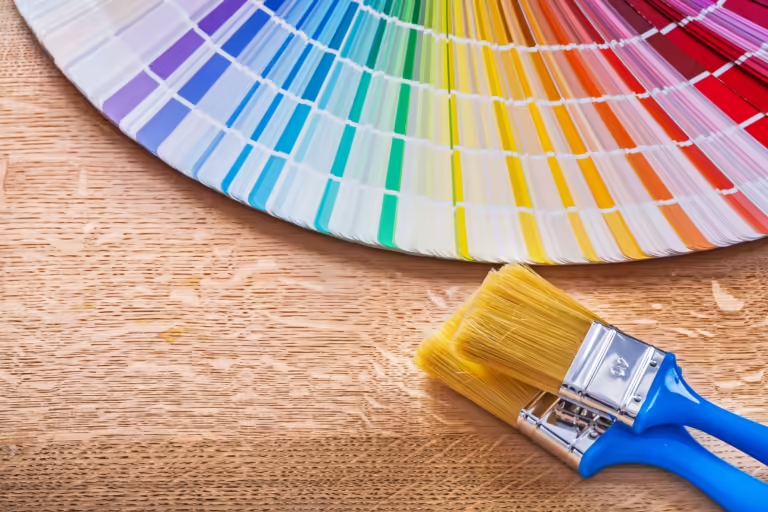
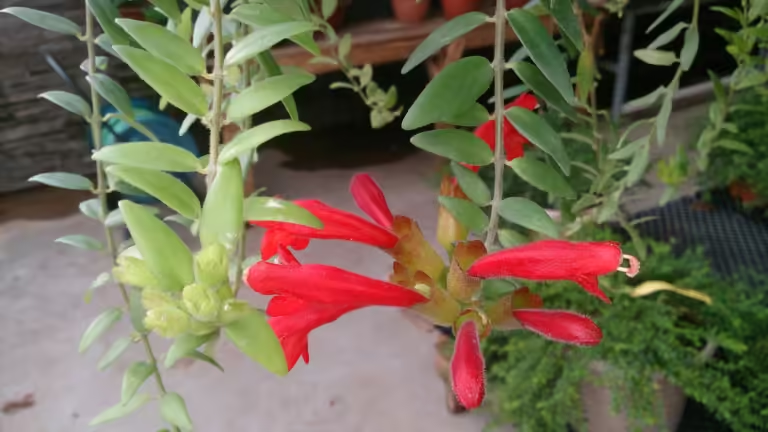
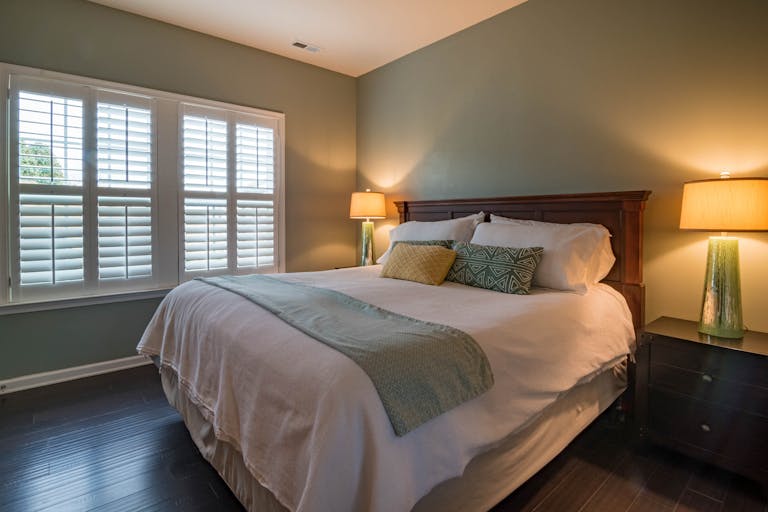
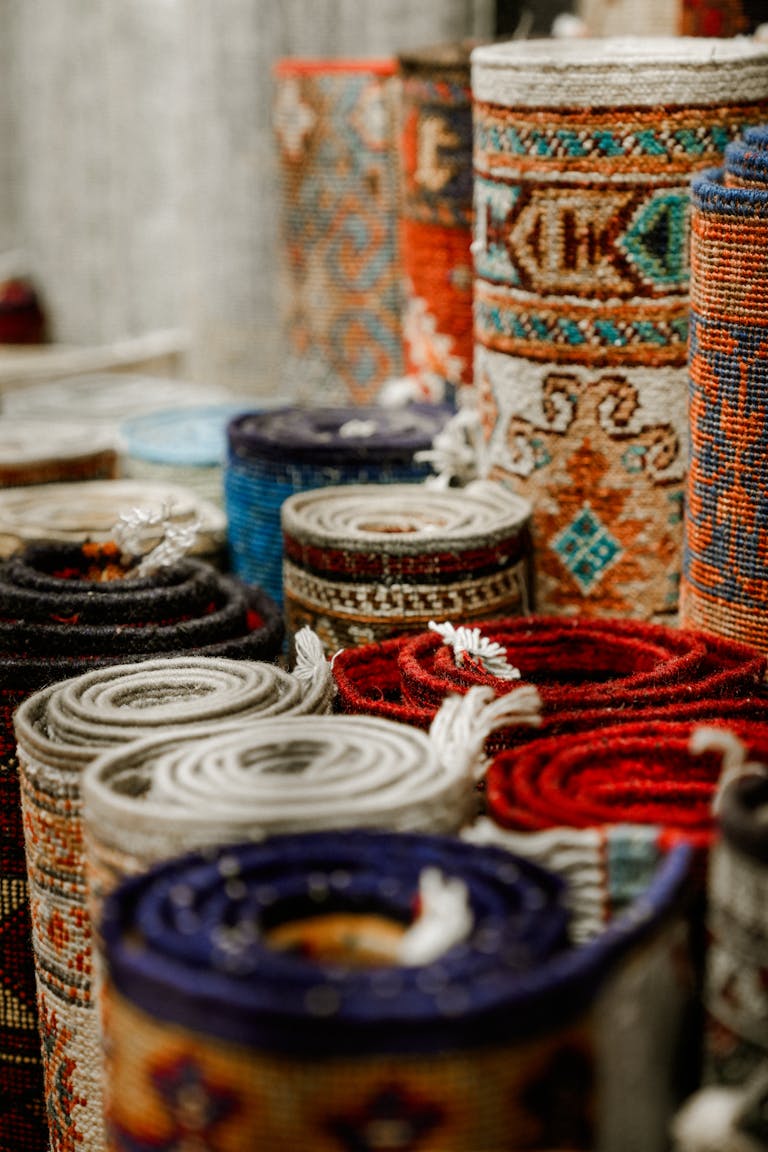
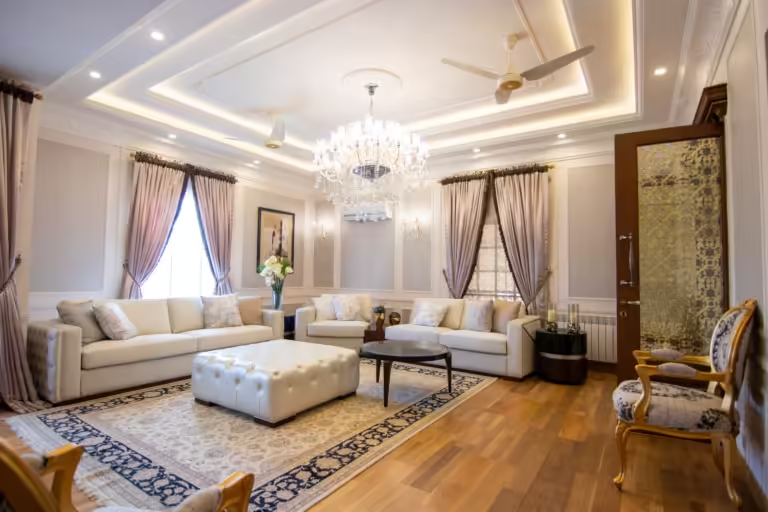
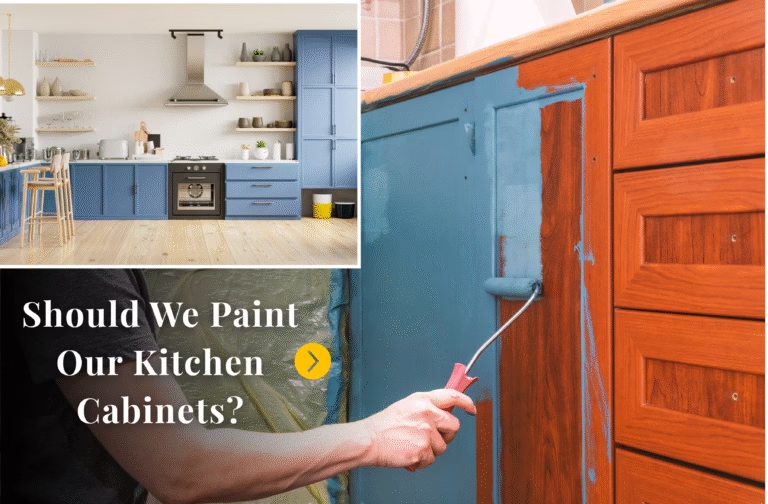
Thanks for addressing this topic.